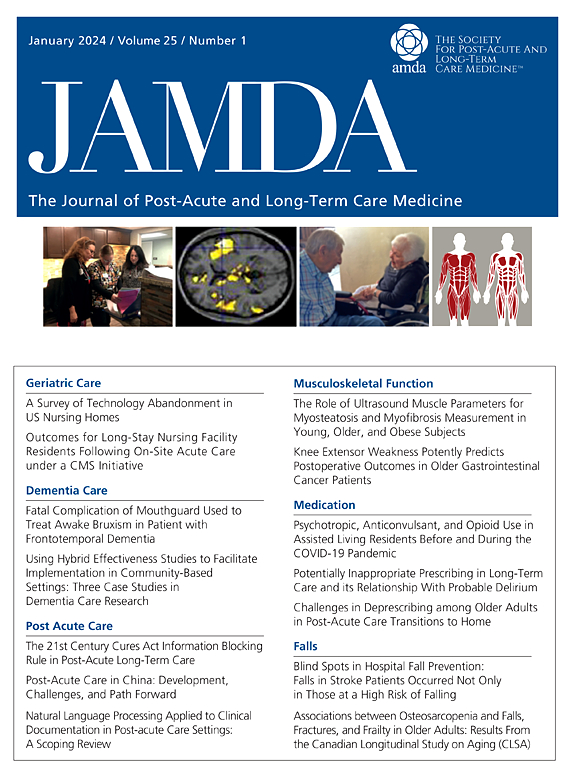音乐移动:长期护理中的代际无声迪斯科派对。
IF 3.8
2区 医学
Q2 GERIATRICS & GERONTOLOGY
Journal of the American Medical Directors Association
Pub Date : 2025-10-01
DOI:10.1016/j.jamda.2025.105833
引用次数: 0
摘要
目的:长期护理(LTC)的老年人经常感到孤独和社会隔离。本研究探讨了居民参加无声迪斯科耳机(SDH)派对的经历,以及代际调解人。目的是研究代际SDH政党在促进社会参与、包容和情感健康方面的可接受性。设计:使用视频人种学和主题分析进行定性研究。环境和参与者:研究在加拿大不列颠哥伦比亚省的一个LTC家庭中进行。参与者包括22名住院医生、2名家庭护理人员和40名参与或观察SDH聚会的工作人员。方法:在6周的时间里,通过录像、对话访谈、观察和与工作人员的焦点小组等方式收集数据。进行主题分析,以确定居民体验中的关键主题。本研究按照COREQ检查表进行报告。结果发现:与学生一起跳舞促进了代际团聚-居民重视年轻辅导员的存在,他们促进了社会联系和情感健康。(2)音乐连接并包含每个人——个性化的音乐选择唤起记忆,鼓励参与,并培养非语言参与。(3)每周两次的聚会建立社会能力——定期的SDH会议创造期待,加强社会联系,并提供分享快乐的时刻。结论和意义:代际SDH政党在减少LTC居民的社会孤立和提高幸福感方面表现出希望。可定制的格式促进自主和有意义的参与,特别是对于有认知或身体障碍的个人。研究结果支持在LTC环境中整合互动的、基于音乐的干预措施,以促进社会联系,提高居民的生活质量。未来的研究应该探索SDH对居民情感和社会健康的长期影响,以及在LTC社区内维持这些项目的最佳实践。本文章由计算机程序翻译,如有差异,请以英文原文为准。
Music Moves: Intergenerational Silent Disco Parties in Long-Term Care
Objectives
Older adults in long-term care (LTC) often experience loneliness and social isolation. This study explores the experiences of residents participating in silent disco headphones (SDH) parties alongside an intergenerational group of facilitators. The objective was to examine the acceptability of intergenerational SDH parties in fostering social engagement, inclusion, and emotional well-being.
Design
Qualitative study using video ethnography and thematic analysis.
Setting and Participants
The study took place in an LTC home in British Columbia, Canada. Participants included 22 residents, 2 family caregivers, and 40 staff members who engaged in or observed the SDH parties.
Methods
Over 6 weeks, data were collected through video recordings, conversational interviews, observations, and focus groups with staff members. Thematic analysis was conducted to identify key themes in residents’ experiences. The study was reported in accordance with the COREQ Checklist.
Results
Three themes emerged: (1) Dancing with students fosters intergenerational togetherness—residents valued the presence of younger facilitators who promoted social connection and emotional well-being. (2) Music connects and includes everyone—personalized music selections evoked memories, encouraged participation, and fostered nonverbal engagement. (3) Party twice a week builds social capacity—regular SDH sessions created anticipation, strengthened social bonds, and offered moments of shared joy.
Conclusions and Implications
Intergenerational SDH parties show promise in reducing social isolation and enhancing well-being in LTC residents. The customizable format promotes autonomy and meaningful engagement, particularly for individuals with cognitive or physical impairments. Findings support the integration of interactive, music-based interventions in LTC settings to foster social connection and improve residents' quality of life. Future research should explore the long-term effects of SDH parties on residents’ emotional and social health, as well as best practices for sustaining these programs within LTC communities.
求助全文
通过发布文献求助,成功后即可免费获取论文全文。
去求助
来源期刊
CiteScore
11.10
自引率
6.60%
发文量
472
审稿时长
44 days
期刊介绍:
JAMDA, the official journal of AMDA - The Society for Post-Acute and Long-Term Care Medicine, is a leading peer-reviewed publication that offers practical information and research geared towards healthcare professionals in the post-acute and long-term care fields. It is also a valuable resource for policy-makers, organizational leaders, educators, and advocates.
The journal provides essential information for various healthcare professionals such as medical directors, attending physicians, nurses, consultant pharmacists, geriatric psychiatrists, nurse practitioners, physician assistants, physical and occupational therapists, social workers, and others involved in providing, overseeing, and promoting quality

 求助内容:
求助内容: 应助结果提醒方式:
应助结果提醒方式:


